1. Magha Puja Festival
Magha Puja Festival, also known as Sangha Day, is one of the most sacred days of Buddhist and is hold in many countries such as Thailand, Campuchia and Laos. Magha Puja day is also called Fourfold Assembly Day.
This holiday occurs each year on the evening of the full moon of the third month of the lunar calendar. As with many Southeast Asian cultures, the traditional lunar calendar is often used to date holidays, celebrations and other festivities and this result in the date of each celebration changing form one year to the next. For 2012, Magha Puja occurs on February 18t, last year it was the 28th of February.
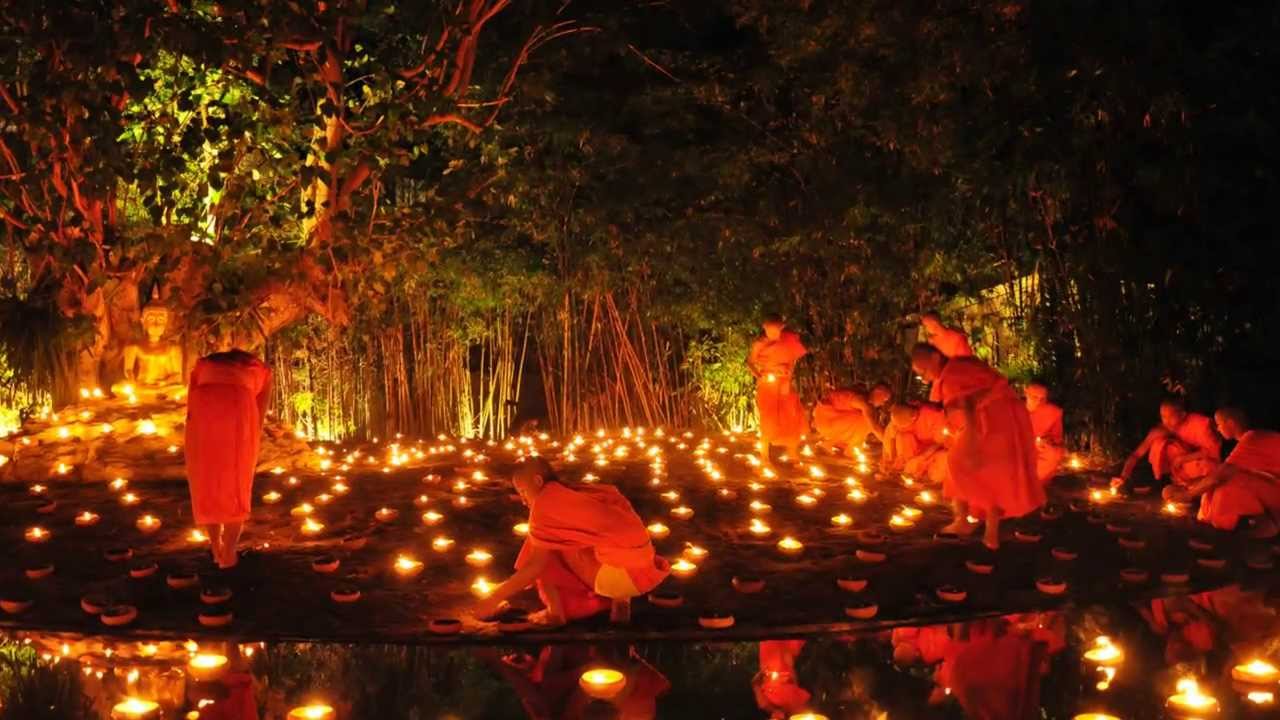
During this event, four good things happen: (1) some 1250 men came to the Buddha without advanced notice (2) the Buddha, himself, ordained the men as monks (3) the Buddha gave special instructions or principles to the new monks and (4) it was the full moon that night. The special principles given were to refrain from all evil, do things that are good and cleanse their minds.
To celebrate this festival, on the night of the full moon of the third lunar month, temples throughout Laos hold a special event. Monks and lay- Buddhists gather together and hold candles, incense and flowers then together they walk around a ceremonial hall. Three times the group circles the hall, clockwise, in honor of the Three Jewels of Buddhism: the Buddha, Dharma and Sangha. There ear other similar ceremonies throughout the three nations, many involving people gathering at temples to honor the event, the history, the Teachings and the Buddha.
2. Vietnamese Tet and Chinese New Year
Vientiane's considerable Vietnamese and Chinese population celebrates Chinese New Year together; the best places to see the celebrations are in the cities of Vientiane, Pakse and Savannakhet.
.jpg)
Like Chinese New Year all around the region, the holiday's three days are marked with raucous parties, exploding firecrackers, and visits to temples and family reunions. Vietnamese and Chinese businesses will be closed at this time. Every people meet each other and always say “Happy new year”. The children was bought new clothes and given lucky money. It is seemed to be the happiest day of Vietnamese and Chinese in Laos.
3. WatPhu Festival
WatPhu Festival is organized annually in Champasak in the full moon of the third month of lunar calendar, on the grounds of the enchanting pre-Angkorian, WatPhou temple. The temple is situated at the food of a sacred mountain called Phou Kao. According to historians, WatPhou is the oldest temple in Laos, the center of Hinduism.
There is a lagend about sacrifice at WatPhou. Phan princess, the daughter of Lord MuongChampaNakhon was captivated by a man but then he left her forever. Because of this suffering, she made a curse: the girls who are captivated to be pregnant like her have to worship God an ox to hear Confessions. If not, crops will be destroyed.
However, sins still happened everywhere. Many girls still made wrong choices. So the baptism took placed annually. Besides, this festival is also an opportunities for the couples to forget sins and wish happiness.
.jpg)
Nowadays, WatPhou ceremony is a Buddhist festival of South Laos, one of the biggest festivals in Laos, held continuously for three days of the lunar full moon in March.
Laotians and people from the neighboring provinces of Northeastern Thailand pilgrimage here. NoongVieng Lake in front of the ancient temple is the center of this festival. Here are elephants racing, buffaloes fighting, cocks fighting and performances of Lao traditional music and dance. The trade fair showcasing the products from the southern province of Laos, Thailand, Cambodia and Vietnam is also held.
4. BounPimai Festival
BounPimai is one of the most important annual festivals (particularly in LuangPrabang) to celebrate Lao New Year which takes place in the middle of the hot summer season, in April (13-15).
The first month of the Lao New Year is actually December but festivities are delayed until April when days are longer than nights. The New Year celebration lasts three days. During the New Year, the Lao believe that the old spirit of Songkran leaves this plane, making way for anew one.
The first day, also known as MahaSongkran, is considered the last day of the old year. Lao will clean their houses and villages on this day, and prepare water, perfume, and flowers for the days ahead. The second day is called the “day of no day” when it is neither part of the old year nor of the New Year. The New Year really start at the third day which is known as Wan Thaloeng.
.jpg)
During BounPimai Festival, water pouring ceremonies play a big part. At each temple, monks will provide the water, as well as blessing for the devotes flocking to the temples and the white baisri strings, which they will tie around devotees’ wrists.
People also get soaked during Bun Pi Mai – people respectfully pour water on monks and elders, and less reverently on each other! Foreigners are not exempt from this treatment – if you're in Laos during Bun Pi Mai, do expect to be soaked by passing teenagers, who'll give you the wet treatment from buckets of water, hoses, or high-pressure water guns.
Other events in LuangPrabang include an annual Nangsoukhane beauty pageant, nightly parties with traditional Lao music and circle dancing, and parades throughout the city. In some of these parades, three outlandishly-dressed figures play leading roles. The two red-faced toothy heads are called Grandfather and Grandmother Nyeu, guardians of the environment and venerated by the people. The lion-headed figure is called Sing Kaew Sing Kham, and he may be an old-time King.
5. Boun Bang Fai Festival
Traditionally, the rocket festival is the sixth Lunar month ceremony that Lao people have conducted for many generation(s). It is a very important event that we could not abandon since the early period of time. It is also the important symbol of unity and friendship used to fight against dry weather and to request rain.
Eventhough, belief in the rain god is less now than in former times, the Lao still respect this tradition and continue to prepare the rocket festival as one of the most significant activities that takes place before of the season of rice cultivation. In addition to the preparation of rockets, there are some Buddhist ceremonies such as waterblessing rituals that the senior monks perform at the same event.
.jpg)
The Rocket festival is the only annual chance the farmers have to request rain from the god called PhayaThaen. Because of the strong belief held since ancient times, when the land was dry and farmers did not have enough water for rice production. So the rocket festival was instituted.
It is the one means for human beings to communicate symbolically with the god to request rain.
6. Khao Phansa Festival
This festival marks the beginning of the traditional three month "rains retreat" during which Buddhist monks are expected to station themselves in a single monastery. It begins at the full moon in July and continues until the full moon in October and all ends with the Kathin ceremony in October when monks receive gifts. During time of festival, monks are not allowed to travel everywhere or revert
According to legend Buddha’s followers did not stop their wandering during the rainy season, that made people complain about their trampling on the rice field and damaging seedlings or small creatures in the fields. When the Buddha heard these worries he forbade the monks to stay in their temples for three months.
During this time devout people often abstain from alcohol. They pray for assistance and guidance to encourage merit and happiness in their lives. It encourages them to follow the five major Buddhist precepts: don’t kill animals; don’t steal or engage in corrupt acts; don’t commit adultery; don’t lie’ and avoid drinking alcohol. They also offer robes to the monks.
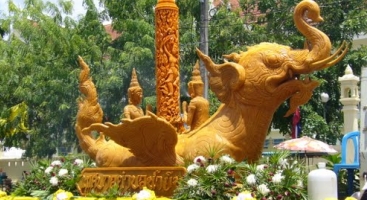
Early the morning of BounKhaoPhansa people prepare donations of food (particularly kaoton, rice, banana or pork wrapped in banana leaves) and necessities like soap, toothpaste and toothbrushes and towels for the monks. Most temples are very busy during this time with people making merit and giving their donations. At the end of these merit- making activities the monks will recite the teachings of Buddha and tell the history of Lent to temple goers. Later in the evening, monks, novices and lay people bring flowers and candles and walk around the central temple three times.
Lent ends on the full moon in October the Kathin ceremony when monks receive gifts. These are the most usual months for ordination and for men to enter the monkhood for short periods before they marry and are marked by numerous ordination ceremonies.
7. Boat Racing Festival
Boat racing is a local festival that takes place every year all around the country during September and October. Most Laos traditional boat racing festivals take place before the end of Buddhist lent. Dates vary from year to year, but most festival are held on weekends.
Traditionally, after the rice planting season villages on the river banks prepare themselves for the upcoming boat racing festival in and around their communities. Teams of rowers are usually sponsored either by big name companies, such as Beer Lao, and telecom companies or by organizations in Vientiane.
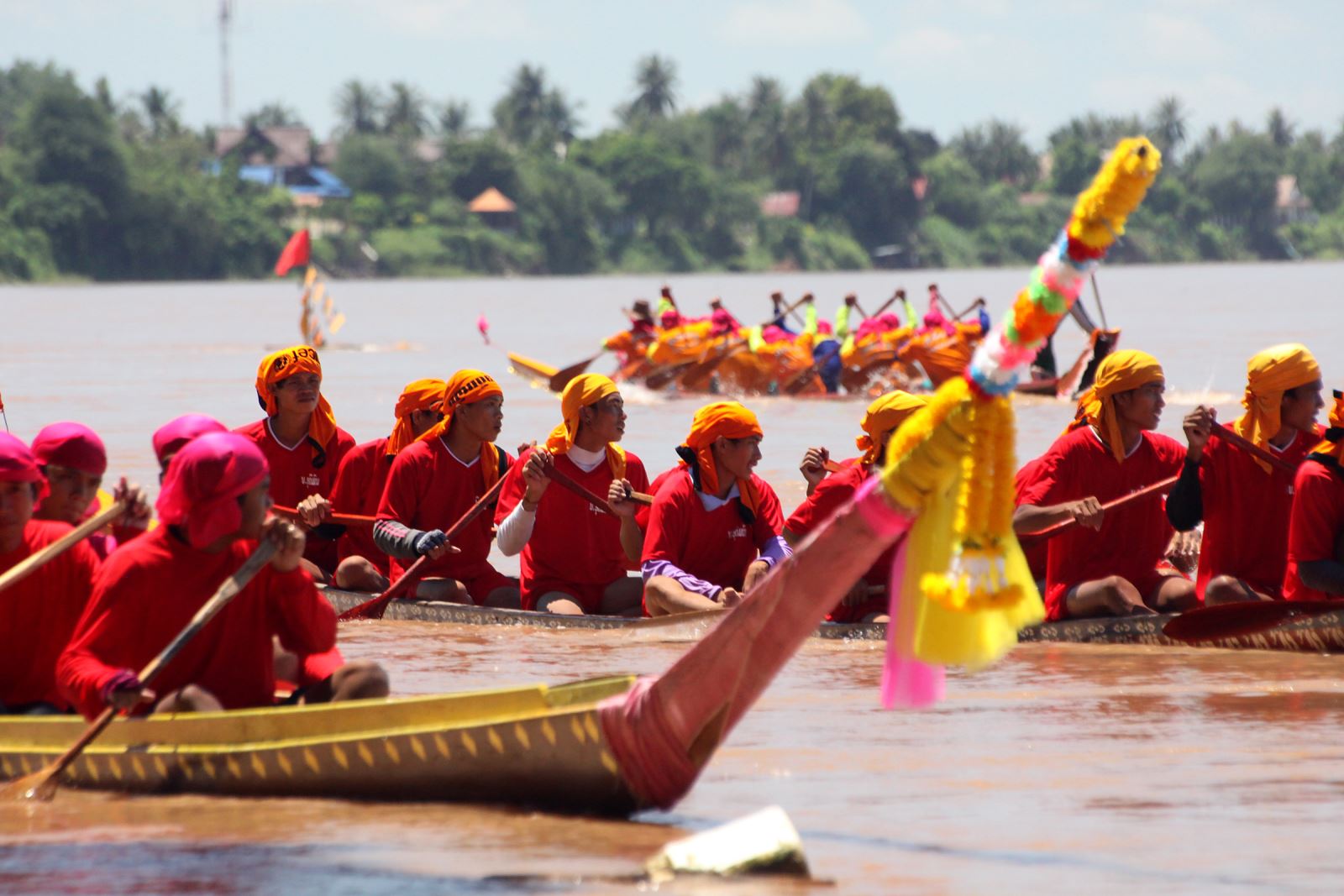
On the race day, every household in the host village prepares special food and drinks. One typical food in this day is noodle which is called Khao Poon in Lao. As guests arrive at their house they are served some noodles and something to drink. This tradition has been carries on for generations and it’s also practiced in BounPavet or Boun Bang Fai.
Besides food and drinks, the host village also needs to build temporary shelters for he invited guests and the rowing crews, to stay the night during days of this festival. These shelters are as simple as bamboo huts or tents. Each families in the village contributes basic stuff like mattresses, pillows and blankets.
Usually, during these days, the town come alive with noise and festivity as the teams make their way to the river either by truck or walking, banging drums and singing. The streets to and along the Mekong river bank are very crowed as thousands of spectators cram along to cheer their teams.
8. Awk Phansa Festival
After the monks have endured the 3 months retreat in their own monastery, they are then allowed to travel again. The last day of the Rains retreat is called "AwkPhansa" which means "leaving the Rains retreat".
This day marks the end of the Buddhist lent and falls on the full moon day of the eleventh lunar month (October).
On the first day at dawn, many people go to the temples around the country to give donations and offerings. In the evening, candlelight processions are held around the temples and it is the celebrations of laiheuafai or Loika Thong, when everyone sends small lighted “boats” made of banana stems or banana leaves decorated with candles and flowers down the river.
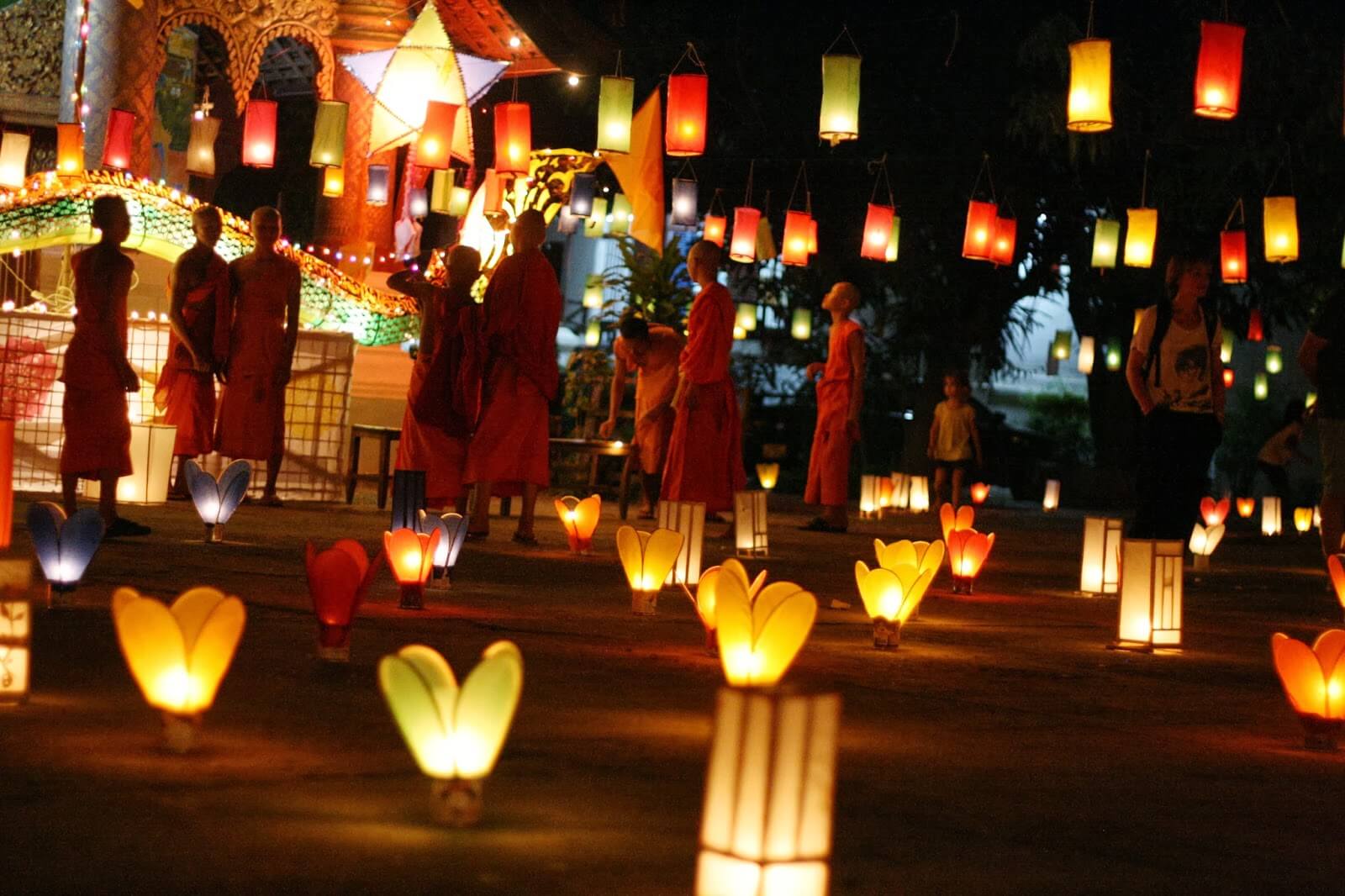
Laotians do this activity to show their respect to the Buddha and gratitude the mother o river for providing water for our lives. Whereas others send the lighted boats down the river to ask for blessing and to float bad luck of the past year away enabling the good luck to flow in. Most towns with a river bank nearby will engage in this lovely ceremony. For villagers from town far from the river, they also prepare model boats decorated with flowers and candlelight. They often take these candlelight in front of their house and do their little prayer wishing for good luck. This colorful rituals have been carried on by Lao people for thousands of years.
9. Boun That Luang Festival
The festival of Boun That Luang is held at The Golden Stupa or Pha That Luang-the most important religious monument in Laos over three-seven days during the full moon of the twelfth lunar month (November, but sometimes October)
The first activity in this festival is a colorful candlelight ‘wax castle’ procession which is held at WatSimeuang. Many groups gather and walk three times around the main hall of worship in honour of the Vientiane city pillar which is considered one of the most important in Vientiane. According to legend, when the pillar was laid, a pregnant woman threw herself to death under the pillar as it was being dropped into position. Nang Si is now seen as the guardian of the city and every year homage is paid to her and Lord Buddha during the festival.
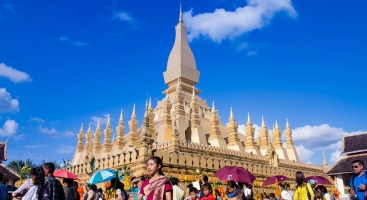
To continue the procession, thousands of people gather to bring their glittering creations to pay homage at That Luang. People often choose their best clothes to wear and there is also a parade of men and women dressed in various Lao ethnic costumes who dance and play traditional music and songs as they approach the stupa.
This festival is a good occasion for many Lao living abroad to come back to visit their family. They sit around together and say what they did in last year and plan a traditional picnic. Lao people also play some traditional game like Tikhy in these days.
The festival draws to a close under a full moon, when people from all over Laos will crowd around the Pha That Luang for one last candlelight procession, bearing posies of flowers, incense and candles. Normally these days there are also firework displays to mark the end of the celebration.
10. Hmong New Year Celebration
The Hmong New Year celebration is a cultural tradition that takes place annually in select areas where large Hmong communities exist and in a modified form where smaller communities come together.
During the New Year's celebration, Hmong dress in traditional clothing and enjoy Hmong traditional foods, dance, music, bull fights, and other forms of entertainment. Hmong New Year celebrations have Hmong ethnic traditions and culture, and may also serve to educate those who have interest in Hmong tradition. Hmong New Year celebrations frequently occur in November and December (traditionally at the end of the harvest season when all work is done), serving as a Thanksgiving holiday for the Hmong people.
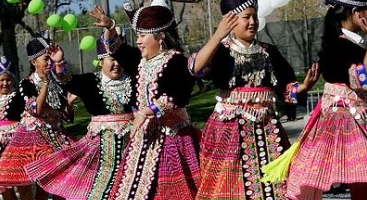
The most interesting activity in the Hmong New Year celebration is a ball tossing game povpob. Boys and girls form two separate lines in pairs. Girls can ball toss with other girls and boys, but boys cannot ball toss with other boys.
Also, during the Hmong New Year celebration, house spirits as well as the spirit of wealth are honored. In addition, if a shaman is in the house, the healing spirits of She-Yee are also honored and released to wander the land (NeebFoobYeem) similar to vacationing after a long year of working until they are called back right after new year. Hmong New Year lasts only for 3 days with 10 dishes of food each day, for a total of 30 dishes thus the Hmong saying “eat 30.”
Source: toursinlaos











